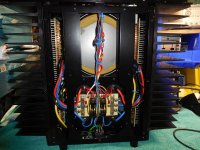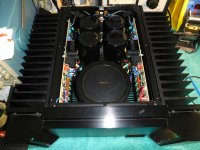I think something is oscillating, and I believe the input terminals are reversed on one PCB, get that backwards and it will do what you are reporting.
Hi Chris,
For testing I've shorted the input wires together, then jumped them to the RCA ground point; they are not connected directly to the jacks.
Also, just verified that the input wires are correctly installed, though that is moot with them shorted during testing.
At first, I didn't have a jumper from the shorted inputs back to ground and that threw off all measurements, but thanks to comments here I corrected that.
The local rail ground cap center tap is also jumpered to the proper location on the PS board under the amp. No speaker wires are connected to the board during testing. I've used the jumpers just so I can test more safely with the modules laying flat next to the main chassis.
I've suspected oscillation from the beginning, based on the burned Zobel resistor, but puzzled why it would occur with shorted inputs and grounds in place.
For testing I've shorted the input wires together, then jumped them to the RCA ground point; they are not connected directly to the jacks.
Also, just verified that the input wires are correctly installed, though that is moot with them shorted during testing.
At first, I didn't have a jumper from the shorted inputs back to ground and that threw off all measurements, but thanks to comments here I corrected that.
The local rail ground cap center tap is also jumpered to the proper location on the PS board under the amp. No speaker wires are connected to the board during testing. I've used the jumpers just so I can test more safely with the modules laying flat next to the main chassis.
I've suspected oscillation from the beginning, based on the burned Zobel resistor, but puzzled why it would occur with shorted inputs and grounds in place.
"When is ground, not ground?" At high frequencies, "ground" is not the same everywhere.
I ask my techs that when I train them early on. Make certain your heat sinks are grounded or it may oscillate, this is true of any amplifier. If your zobel burned out - you are oscillating at a high level for certain.
I ask my techs that when I train them early on. Make certain your heat sinks are grounded or it may oscillate, this is true of any amplifier. If your zobel burned out - you are oscillating at a high level for certain.
I'm waiting for some resistors and other parts, but in the meantime have found several cracked solder joints on both boards that I've repaired. On the L ch. board, many were around the overheated area of the board at Q110, Q111, Q112, as well as the power and speaker screw connectors. The R ch. board had fewer bad joints, but I may have just repaired more of those when I reflowed previously.
Parts should arrive Friday but I'll be shelving this over the weekend to attend BAF, then we have painters in the house for a week, so I might only be able to do some additional parts checking, including re-checking ZD12 for correct voltage out of circuit.
I'm glad Q114 and Q115, the predrivers, appear to be good, as they are apparently not easily substituted with current parts.
I appreciate the assistance and guidance so far - more to report when possible.
Greg
Parts should arrive Friday but I'll be shelving this over the weekend to attend BAF, then we have painters in the house for a week, so I might only be able to do some additional parts checking, including re-checking ZD12 for correct voltage out of circuit.
I'm glad Q114 and Q115, the predrivers, appear to be good, as they are apparently not easily substituted with current parts.
I appreciate the assistance and guidance so far - more to report when possible.
Greg
OK, thank you, Chris. Thought I had cleaned all of these up previously, but found more when I really scrutinized everything with magnifier visor and brighter light.
Man, no kidding. Not only resolution, but contrast, depth perception, and low light reception keep going down as my age is going up. Oy.
Closing the loop on this repair.
After struggling with trying to nail down the various problems, I moved on to other projects in October last year. A couple of weeks ago I plucked up the courage to try to finally repair the amp. A few more components were replaced because they were out of spec, and the small thermistor board on the left channel turned out to have a cracked trace for Q139, with intermittent and incomplete contact. I repaired the board and double-checked the right channel board.
Even with the main boards under a USB microscope and under magnifying visors, I couldn't find any other physical issues. However, thankfully, Chris (anatech) was extremely helpful to me offline, and gave me a sequence of recommended measurements to take after I reported to him that the unit simply wouldn't bias up. His solution was to sub in a trimmer at R113 and adjust until Q110 and Q112 switched on completely, setting the proper current through Q114 and Q115. The adjusted values were about 250R higher than the 1k2R resistors in those positions, so I replaced the trimmers with the appropriate resistors, and that solved the problem!
Yesterday I ran the amp up to full power and beyond (rated at 225WPC, but it had a clean sine wave past 240WPC), with both channels very well matched. Of course, all new output devices helped with that!
The amp has been running for a couple of one hour sessions today, and I'll put it through a few more cycles and fine bias tuning as needed.
Sooo nice to have this amp back on the road! Many thanks, Chris, and to those with prior helpful suggestions.
After struggling with trying to nail down the various problems, I moved on to other projects in October last year. A couple of weeks ago I plucked up the courage to try to finally repair the amp. A few more components were replaced because they were out of spec, and the small thermistor board on the left channel turned out to have a cracked trace for Q139, with intermittent and incomplete contact. I repaired the board and double-checked the right channel board.
Even with the main boards under a USB microscope and under magnifying visors, I couldn't find any other physical issues. However, thankfully, Chris (anatech) was extremely helpful to me offline, and gave me a sequence of recommended measurements to take after I reported to him that the unit simply wouldn't bias up. His solution was to sub in a trimmer at R113 and adjust until Q110 and Q112 switched on completely, setting the proper current through Q114 and Q115. The adjusted values were about 250R higher than the 1k2R resistors in those positions, so I replaced the trimmers with the appropriate resistors, and that solved the problem!
Yesterday I ran the amp up to full power and beyond (rated at 225WPC, but it had a clean sine wave past 240WPC), with both channels very well matched. Of course, all new output devices helped with that!
The amp has been running for a couple of one hour sessions today, and I'll put it through a few more cycles and fine bias tuning as needed.
Sooo nice to have this amp back on the road! Many thanks, Chris, and to those with prior helpful suggestions.
The listening test is complete, and the sound quality is fantastic. Better than before all of the work, which is encouraging considering it has all new drivers and outputs, many new IPS and VAS transistors, bias transistors, new electrolytic caps on the boards, and a passel of other parts.
Bass extension is deeper and tighter. Mids and highs are very nicely detailed, and the sense of channel separation and space seems greater than before, though that is hard to tell after several months. The amp is really quiet, with no hum or background noise. After a couple of hours of music, I let it idle and re-set bias to 40mA. It might be time to screw down the top cover and call this good!
Bass extension is deeper and tighter. Mids and highs are very nicely detailed, and the sense of channel separation and space seems greater than before, though that is hard to tell after several months. The amp is really quiet, with no hum or background noise. After a couple of hours of music, I let it idle and re-set bias to 40mA. It might be time to screw down the top cover and call this good!
- Home
- Amplifiers
- Pass Labs
- Nakamichi PA7II serious problems, need ideas, please



